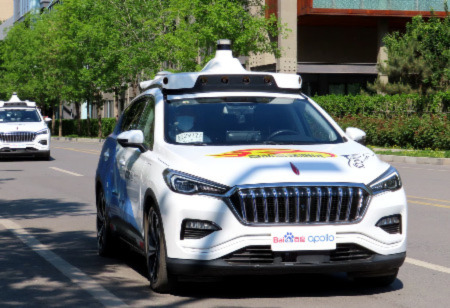
China is Driving in the Fast Lane with Driverless Vehicles among Global Competitors


Toyota-backed autonomous vehicle company, Pony.ai became the first autonomous driving company to receive a commercial taxi license in China. The robotaxi company Pony.ai began running hundred driverless vehicles in the Nansha area, Guangzhou with hopes of expanding the same to other parts of the city.
After this breakthrough, Baidu and Pony.ai were given permission to run autonomous ride-hailing services for the general public on Beijing's open roadways. As part of the Beijing High-Level Automated Driving, Baidu was able to add ten driverless cars to its existing Apollo Go fleet, which currently numbers about 100 vehicles in the nation's capital. Customers of Pony can book a ride via the PonyPilot+ app from 9 am to 5 pm, while Apollo Go users can do so from 10 am to 4 pm.
However, Beijing's permission necessitates the presence of a safety operator in the front passenger seat, unlike California's driverless licenses, which only require the presence of the passenger. Although several Chinese cities have given manufacturers of autonomous vehicles permission to conduct testing without a human safety operator at the wheel, this is the first time a completely driverless service has received approval.The Chinese car industry has come a long way since 2016, when the young but ambitious entrepreneurs began making inroads into the autonomous vehicle market, so this is still a significant chapter for the country.
Citizens are also welcoming the flourishing of autonomous vehicles, there is rising demand from customers and the government is also cheering for the sector by rolling out a bunch of growth booster initiatives.
Regulatory Support from the Government
To start with, in 2015, the State Council announced the national strategy plan Made in China 2025 aiming to transform the country’s manufacturing industry. Few objectives under this plan entail the development of intelligent equipment and goods, while promoting study and commercialization of self-driving vehicles.
Under the same Made in China 2025 strategy, including the National Road Testing Guideline, the country introduced major legislations and regulations on self-driving cars in 2017. These regulations aided the legitimization of business and standardization of its products.
In 2021, the country gave a revision to its regulations on driverless car testing to allow qualified companies to trial autonomous vehicles to transport goods and passengers on highways and city roads. This was aimed to speed up the commercialization of self-driving technology.
Followed by the Standing Committee of the Shenzhen Municipal People’s Congress a draft for Comments of Shenzhen Special Economic Zone Regulations on the Administration of Intelligent and Connected Vehicles was launched on its website to welcome public comments. Under these regulations autonomous vehicle development, including road testing, access registration, usage management, road transport, traffic accidents, accidents, violation handling, and legal liability are covered. Also this indicates Shenzhen’s efforts to be the first city to commercialize driverless vehicles.
Next day, the Ministry of Public Security of China proposed draft amendments to the road safety law to stress the requirements for road testing and access by cars with autonomous driving capabilities, while ensuring allocation of accountability for traffic offenses and accidents.
Then a total of 27 provinces and municipalities established 16 autonomous driving demonstration zones, opened 3,500 kilometers of test road and introduced regulations on self-driving vehicles.
Citizens with autonomous vehicles, that involve zero autonomy, to L15 with full autonomy are granted license for pilot zones. In particular to L15 autonomous vehicles Shenzen has rolled out regulations to govern it.
For autonomous shipping, the central government released new guidelines during its 14th Five -Year - Plan while rolling out relevant regulations.
Shanghai authorities introduced measures that promote the development of self-driving technology last year, as well as, pushing forward the commercialization process. Shanghai is also supporting Pudong New Area's legislation for autonomous driving without in-car safety operators. Although without in-car safety operators doesn’t mean that the car can completely bypass safety operators, since remote monitoring systems are always there.
In the same year, the State Administration for Market Regulation and the Standardization Administration introduced the first national guidelines for grading autonomous vehicles to enable automakers to develop future technology.
Support for Technology Stack development
The autonomous driving industry value chain requires numerous software and hardware technology stacks, and each one can present a business opportunity for regional vendors. Some companies have already developed to the point where they can serve as tier-1 or even tier-0.5 suppliers in the main value chain. Meanwhile, a number of regional suppliers in industries including core algorithms, LiDAR, and AI processors have elevated to top international positions.
Chinese start-ups are continuing to appear in the market for personal autonomous vehicles (PAVs) and robo-taxis, as well as in commercial ADAS application scenarios like line-haul logistics, ports, and mines.
Commercialization
From a small industry to one that has received substantial support from both the government and major business players, giving rise to a class of start-ups that are attempting to commercialize their innovations in an effort to be the first to market a workable product.
China's autonomous driving industry has entered a new phase as it moves from testing and demonstration to commercialization pilot. Chinese tech giant Baidu Inc. and self-driving start-up Pony.ai received approval in November to begin offering for-hire driverless Robotaxi services in a neighborhood in Yizhuang, Beijing.
UISEE has expanded its commercialization efforts in 2021, introducing full-scene autonomous driving in a variety of contexts, including airports, industrial settings, and unmanned buses. UISEE has been deploying full-scene autonomous driving from the very beginning.

